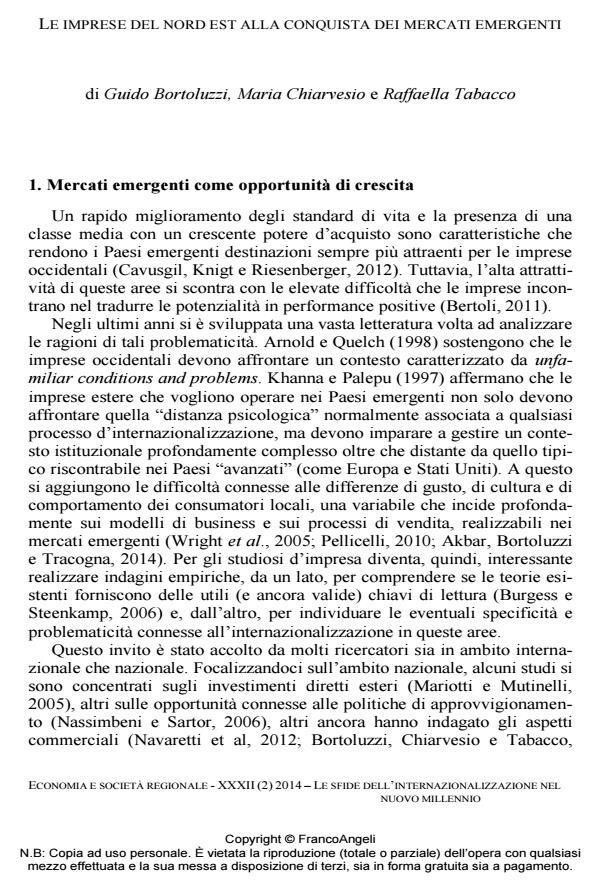Le imprese del Nord Est alla conquista dei mercati emergenti
Journal title ECONOMIA E SOCIETÀ REGIONALE
Author/s Guido Bortoluzzi, Marina Chiarvesio, Raffaella Tabacco
Publishing Year 2014 Issue 2014/2 Language Italian
Pages 13 P. 31-43 File size 342 KB
DOI 10.3280/ES2014-002003
DOI is like a bar code for intellectual property: to have more infomation
click here
Below, you can see the article first page
If you want to buy this article in PDF format, you can do it, following the instructions to buy download credits

FrancoAngeli is member of Publishers International Linking Association, Inc (PILA), a not-for-profit association which run the CrossRef service enabling links to and from online scholarly content.
- Balboni B., Grappi S., Martinelli E. e Vignola M. (2011). L’impatto del Made in Italy sul comportamento d’acquisto dei consumatori cinesi. Micro&Macro Marketing, 3.
- Bertoli G. (2011). Editoriale. Micro&Macro Marketing, 3.
- Akbar Y., Bortoluzzi G. e Tracogna A. (2014). Beyond Entry Mode - SME Escalation in Emerging Markets: A Conceptual Framework. Journal for International Business and Entrepreneurship Development, 7(4): 326-340.
- Arnold D.J. e Quelch J.A (1998). New Strategies in Emerging Markets. Sloan
- Management Review, 40(1): 7-20. Balboni B., Bortoluzzi G. e Grandinetti R. (2013). On the relationship between size, capabilities and internationalization: An explorative analysis of Italian subcontracting SMEs. International Journal of Globalisation and Small business, 5(1/2): 114-132.
- Bertoli G. e Pittella S. (2009). Passaggio in India per le imprese italiane: l’esperienza Ferrero. Micro&Macro Marketing, 1: 159-192.
- Bertoli G. e Resciniti R. (2013). Made in Italy e country of origin effect. Mercati e competitività, 2.
- Bettiol M., Chiarvesio M., Di Maria E. e Tabacco R. (2013). Internationalization strategies of luxury firms in China: the role of design and marketing capabilities. “Marco Fanno” Working Papers, 0157.
- Bortoluzzi G., Chiarvesio M. e Tabacco R. (2012). Servizi a supporto della manifattura per i mercati emergenti, Economia e società regionale, 3.
- Bortoluzzi G., Chiarvesio M. e Tabacco R. (2014). Organizzare e gestire la distribuzione nel mercato indiano. Esperienze dal settore dell’arredamento italiano. Micro & Macro Marketing, 1
- Burgess S.M. e Steenkamp Jan-Benedict E.M. (2006). Marketing renaissance: How research in emerging markets advances marketing science and practice. International Journal of Research in Marketing, 23: 337-356.
- Cavusgil S.T., Knight G. e Riesenberger J. (2012). International Business: The New Realities. New Jersey: Pearson Education.
- Chiarvesio M. e Tabacco R. (2012). Strategie di internazionalizzazione commerciale nei mercati emergenti: i casi Savio Meccaniche Tessili e Stark. Micro& Macro Marketing, 1.
- Corò G. e Grandinetti R. (2010). Frontiere e attori dello sviluppo oltre la crisi: il laboratorio del Nord Est. Economia e società regionale, 2: 43-63.
- Corsi S., Di Minin A. e Piccaluga A. (2012). Internazionalizzazione come fonte di innovazione: il caso Carel in Cina. Economia e società regionale, 2: 179-184.
- Dawar N. e Chattopadhyay A. (2002). Rethinking Marketing Programs for Emerging Markets. Long Range Planning, 35: 457-474.
- Dong M.C., Tse D. e Hung K. (2010). Effective Distributor Governance in Emerging Markets: The Salience of Distributor Role, Relationship Stage, and Market Uncertainty. Journal of International Marketing, 18(3): 1-17.
- Grandinetti R. e Nassimbeni G. (2007). Le dimensioni della crescita aziendale. Milano: FrancoAngeli.
- Hyvönen S. e Tuominen M. (2007). Channel Collaboration, Market Orientation and Performance Advantages: Discovering Developed and Emerging Markets. The International Review of Retail, Distribution and Consumer Research, 17(5): 423-445. Johanson J. e Vahlne J.E. (1977). The internationalization process of the firm: a model of knowledge development and increasing foreign market commitments. Journal of International Business Studies, 8(1): 23-32.
- Johanson J. e Vahlne J.E. (2009). The Uppsala internationalization process model revisited: from liability of foreignness to liability of outsidership. Journal of International Business Studies, 40(9): 1411-1431.
- Khanna T. e Palepu K. (1997). Why Focused Strategies May Be Wrong for Emerging Markets. Harvard Business Review, July-August: 41-51.
- Mariotti S. e Mutinelli M. (2005). La presenza italiana in Cina. Economia e politica industriale, 3.
- Nassimbeni G. e Sartor M. (2006). International purchasing offices in China. Production Planning & Control: The Management of Operations, 17(5).
- Navaretti G.B., Bugamelli M., Cristadoro R. e Maggioni D. (2012). Are firms exporting to China and India different from other exporters?. EFIGE Working paper, 4.
- Pellicelli G. (2010). Mercati emergenti. Strategie per competere oltre confine. Milano: Egea.
- Sandberg S. (2014). Experiential knowledge antecedents of the SME network node configuration in emerging market business networks. International Business Review, 23: 20-29
- Vescovi T. (2011). Libellule sul drago. Modelli di business e strategie di marketing delle imprese italiane in Cina. Padova: Cedam.
- Vianelli D., de Luca P. e Pegan G. (2012). Modalità d’entrata e scelte distributive del made in Italy in Cina. Milano: FrancoAngeli.
- Wright M., Filatotchev I., Hoskisson R.E. e Peng M.W. (2005). Strategy Research in Emerging Economies: Challenging the Conventional Wisdom. Journal of Management Studies, 42(1): 1-33.
Guido Bortoluzzi, Marina Chiarvesio, Raffaella Tabacco, Le imprese del Nord Est alla conquista dei mercati emergenti in "ECONOMIA E SOCIETÀ REGIONALE " 2/2014, pp 31-43, DOI: 10.3280/ES2014-002003